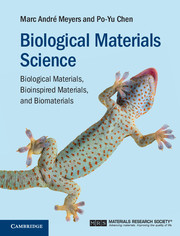Book contents
- Frontmatter
- Epigraph
- Contents
- Preface
- List of Boxes
- 1 Evolution of materials science and engineering: from natural to bioinspired materials
- Part I Basic biology principles
- Part II Biological materials
- 6 Silicate- and calcium-carbonate-based composites
- 7 Calcium-phosphate-based composites
- 8 Biological polymers and polymer composites
- 9 Biological elastomers
- 10 Biological foams (cellular solids)
- 11 Functional biological materials
- Part III Bioinspired materials and biomimetics
- References
- Index
7 - Calcium-phosphate-based composites
from Part II - Biological materials
Published online by Cambridge University Press: 05 August 2014
- Frontmatter
- Epigraph
- Contents
- Preface
- List of Boxes
- 1 Evolution of materials science and engineering: from natural to bioinspired materials
- Part I Basic biology principles
- Part II Biological materials
- 6 Silicate- and calcium-carbonate-based composites
- 7 Calcium-phosphate-based composites
- 8 Biological polymers and polymer composites
- 9 Biological elastomers
- 10 Biological foams (cellular solids)
- 11 Functional biological materials
- Part III Bioinspired materials and biomimetics
- References
- Index
Summary
Introduction
Hydroxylapatite or hydroxyapatite (HAP) is a calcium-phosphate-based mineral of the apatite family. Its chemical formula is Ca10(PO4)6(OH)2. It can be found widely in nature and is the major component of bone, enamel, and dentin in teeth, antler, ganoid fish scales (in alligator gar and Senegal bichir), turtle shells, and armadillo and alligator osteoderms. It exists in minute quantities in the brain (brain sand), without significantly affecting its function. Thus, the expression “having sand in the head” is not without reason. The density of HAP is 3.15 g/cm3. Nonstoichiometric minerals can exist with Ca10(PO4)6(OH, F, Cl, Br)2; if the OH group is replaced by F it is called fluoroapatite; if it is replaced by Cl, it is called chloroapatite. It can be occasionally used as a gem, and the cat’s eye is a commonly known use.
In this chapter, we will concentrate on bone and teeth with emphasis on their structure and mechanical properties. They are HAP–collagen composites and their mechanical properties are the result of the complex interplay and hierarchy built by these structures. Selected calcium-phosphate-based bony tissues with unique functionalities, such as antler, turtle shells, alligator osteoderms, and fish scales, will also be described in the second part of this chapter.
- Type
- Chapter
- Information
- Biological Materials ScienceBiological Materials, Bioinspired Materials, and Biomaterials, pp. 223 - 291Publisher: Cambridge University PressPrint publication year: 2014



